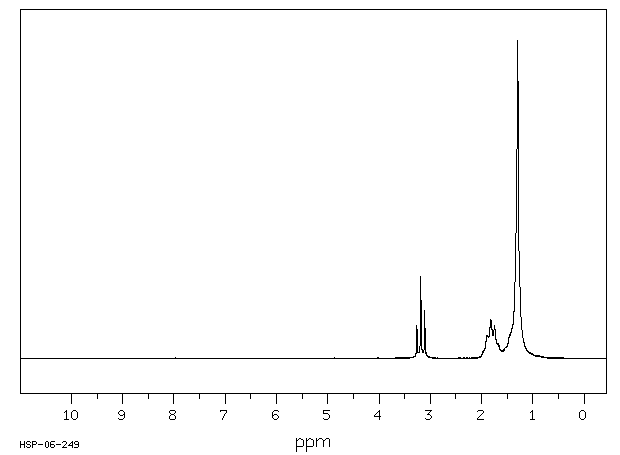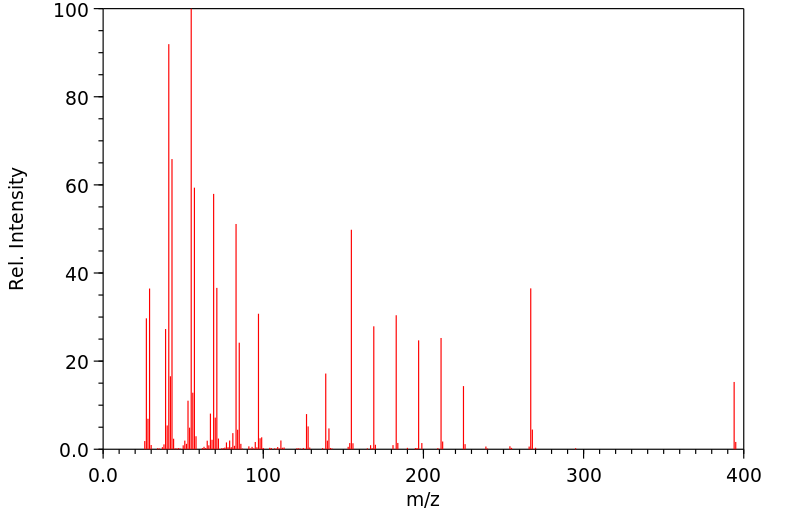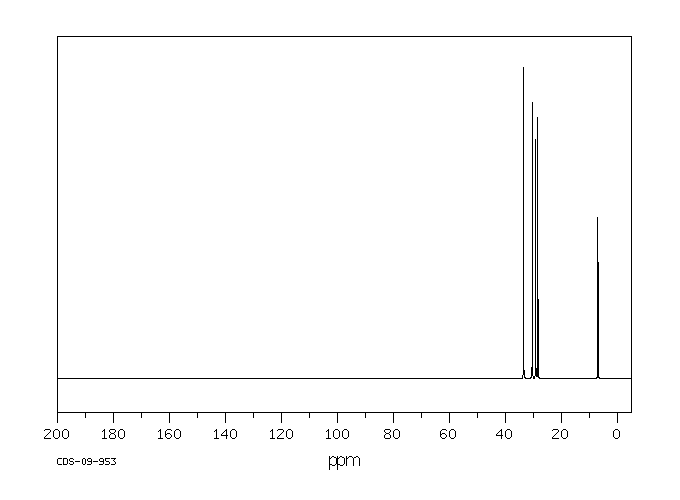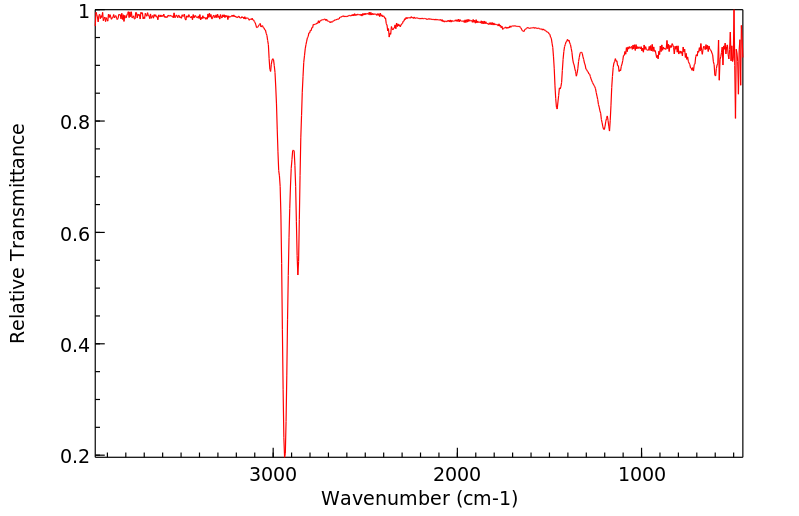1,10-二碘癸烷 | 16355-92-3
中文名称
1,10-二碘癸烷
中文别名
双碘癸烷
英文名称
1,10-diiododecane
英文别名
——
CAS
16355-92-3
化学式
C10H20I2
mdl
MFCD00001086
分子量
394.078
InChiKey
CKJCTZAIDVFHCX-UHFFFAOYSA-N
BEILSTEIN
——
EINECS
——
-
物化性质
-
计算性质
-
ADMET
-
安全信息
-
SDS
-
制备方法与用途
-
上下游信息
-
文献信息
-
表征谱图
-
同类化合物
-
相关功能分类
-
相关结构分类
物化性质
-
熔点:33-35 °C (lit.)
-
沸点:197-200 °C/12 mmHg (lit.)
-
密度:2,35 g/cm3
-
闪点:>230 °F
-
溶解度:溶于甲醇。
-
稳定性/保质期:
在常温常压下保持稳定,应避免与氧化物和光接触。
计算性质
-
辛醇/水分配系数(LogP):6.8
-
重原子数:12
-
可旋转键数:9
-
环数:0.0
-
sp3杂化的碳原子比例:1.0
-
拓扑面积:0
-
氢给体数:0
-
氢受体数:0
安全信息
-
TSCA:Yes
-
危险等级:6.1(b)
-
安全说明:S26,S37/39
-
危险品运输编号:2811
-
WGK Germany:3
-
海关编码:2903399090
-
危险类别:6.1(b)
-
危险品标志:Xi
-
危险类别码:R36/37/38
-
包装等级:III
-
危险性防范说明:P261,P305+P351+P338
-
危险性描述:H315,H319,H335
-
储存条件:常温下应密闭避光保存,并放置于通风干燥处。
SDS
| Name: | 1 10-Diiododecane 97% Material Safety Data Sheet |
| Synonym: | |
| CAS: | 16355-92-3 |
Synonym:
Section 2 - COMPOSITION, INFORMATION ON INGREDIENTS
| CAS# | Chemical Name | content | EINECS# |
| 16355-92-3 | 1,10-Diiododecane | 97 | 240-415-6 |
Risk Phrases: None Listed.
Section 3 - HAZARDS IDENTIFICATION
EMERGENCY OVERVIEW
Light sensitive.The toxicological properties of this material have not been fully investigated.
Potential Health Effects
Eye:
May cause eye irritation. No information regarding eye irritation and other potential effects was found.
Skin:
May cause skin irritation. No information regarding skin irritation and other potential effects was found.
Ingestion:
The toxicological properties of this substance have not been fully investigated.
Inhalation:
The toxicological properties of this substance have not been fully investigated.
Chronic:
Not available.
Section 4 - FIRST AID MEASURES
Eyes: Flush eyes with plenty of water for at least 15 minutes, occasionally lifting the upper and lower eyelids. Get medical aid immediately.
Skin:
Get medical aid. Flush skin with plenty of water for at least 15 minutes while removing contaminated clothing and shoes.
Ingestion:
If victim is conscious and alert, give 2-4 cupfuls of milk or water.
Never give anything by mouth to an unconscious person. Get medical aid.
Inhalation:
Remove from exposure and move to fresh air immediately. If not breathing, give artificial respiration. If breathing is difficult, give oxygen. Get medical aid.
Notes to Physician:
Section 5 - FIRE FIGHTING MEASURES
General Information:
As in any fire, wear a self-contained breathing apparatus in pressure-demand, MSHA/NIOSH (approved or equivalent), and full protective gear.
Extinguishing Media:
Use water spray, dry chemical, carbon dioxide, or appropriate foam.
Section 6 - ACCIDENTAL RELEASE MEASURES
General Information: Use proper personal protective equipment as indicated in Section 8.
Spills/Leaks:
Sweep up or absorb material, then place into a suitable clean, dry, closed container for disposal.
Section 7 - HANDLING and STORAGE
Handling:
Wash thoroughly after handling. Use only in a well-ventilated area.
Avoid contact with eyes, skin, and clothing. Avoid ingestion and inhalation.
Storage:
Keep container closed when not in use. Store in a cool, dry, well-ventilated area away from incompatible substances.
Section 8 - EXPOSURE CONTROLS, PERSONAL PROTECTION
Engineering Controls:
Use adequate ventilation to keep airborne concentrations low.
Exposure Limits CAS# 16355-92-3: Personal Protective Equipment Eyes: Wear appropriate protective eyeglasses or chemical safety goggles as described by OSHA's eye and face protection regulations in 29 CFR 1910.133 or European Standard EN166.
Skin:
Wear appropriate protective gloves to prevent skin exposure.
Clothing:
Wear appropriate protective clothing to prevent skin exposure.
Respirators:
Follow the OSHA respirator regulations found in 29 CFR 1910.134 or European Standard EN 149. Use a NIOSH/MSHA or European Standard EN 149 approved respirator if exposure limits are exceeded or if irritation or other symptoms are experienced.
Section 9 - PHYSICAL AND CHEMICAL PROPERTIES
Physical State: Crystals
Color: off-white crystal to orange liquid - after melting,
Odor: None reported.
pH: Not available.
Vapor Pressure: Not available.
Viscosity: Not available.
Boiling Point: 197.0 - 200.0 deg C @ 12.00mm
Freezing/Melting Point: 28.00 - 32.00 deg C
Autoignition Temperature: Not available.
Flash Point: 110 deg C ( 230.00 deg F)
Explosion Limits, lower: Not available.
Explosion Limits, upper: Not available.
Decomposition Temperature:
Solubility in water:
Specific Gravity/Density:
Molecular Formula: C10H20I2
Molecular Weight: 394.07
Section 10 - STABILITY AND REACTIVITY
Chemical Stability:
Stable under normal temperatures and pressures.
Conditions to Avoid:
Incompatible materials, light.
Incompatibilities with Other Materials:
Strong oxidizing agents, strong bases.
Hazardous Decomposition Products:
Carbon monoxide, carbon dioxide, hydrogen iodide.
Hazardous Polymerization: Has not been reported.
Section 11 - TOXICOLOGICAL INFORMATION
RTECS#:
CAS# 16355-92-3 unlisted.
LD50/LC50:
Not available.
Carcinogenicity:
1,10-Diiododecane - Not listed by ACGIH, IARC, or NTP.
Section 12 - ECOLOGICAL INFORMATION
Section 13 - DISPOSAL CONSIDERATIONS
Dispose of in a manner consistent with federal, state, and local regulations.
Section 14 - TRANSPORT INFORMATION
IATA
Not regulated as a hazardous material.
IMO
Not regulated as a hazardous material.
RID/ADR
Not regulated as a hazardous material.
Section 15 - REGULATORY INFORMATION
European/International Regulations
European Labeling in Accordance with EC Directives
Hazard Symbols: Not available.
Risk Phrases:
Safety Phrases:
S 24/25 Avoid contact with skin and eyes.
WGK (Water Danger/Protection)
CAS# 16355-92-3: No information available.
Canada
CAS# 16355-92-3 is listed on Canada's NDSL List.
CAS# 16355-92-3 is not listed on Canada's Ingredient Disclosure List.
US FEDERAL
TSCA
CAS# 16355-92-3 is listed on the TSCA inventory.
SECTION 16 - ADDITIONAL INFORMATION
N/A
制备方法与用途
上下游信息
反应信息
-
作为反应物:参考文献:名称:雷尼镍:一种有效的有机卤化物还原脱卤试剂摘要:Raney镍是一种有效的试剂,用于实现有机卤化物的化学选择性还原脱卤。在这种实验条件下,氟化物和烯烃卤化物不发生反应。DOI:10.1055/s-2001-12325
-
作为产物:参考文献:名称:促乙酸素的γ-甲基丁烯内酯单元的Sharpless AD策略:具有蚊幼虫活性的丁烯内酯I和II的对映选择性合成摘要:基于Sharpless不对称二羟基化技术,以高收率和良好的对映体纯度为基础,建立了一种针对γ-甲基丁烯内酯的新型合成策略。该途径可扩展为合成天然存在的非丙酮产乙酸原素的α,γ-二取代丁烯内酯单元。利用这种策略,对映体选择性合成了三种具有丁烯内酯链段的简单天然产物。DOI:10.1016/s0040-4020(02)01063-3
文献信息
-
Probing the Existence of a Metastable Binding Site at the β<sub>2</sub>-Adrenergic Receptor with Homobivalent Bitopic Ligands作者:Birgit I. Gaiser、Mia Danielsen、Emil Marcher-Rørsted、Kira Røpke Jørgensen、Tomasz M. Wróbel、Mikael Frykman、Henrik Johansson、Hans Bräuner-Osborne、David E. Gloriam、Jesper Mosolff Mathiesen、Daniel Sejer PedersenDOI:10.1021/acs.jmedchem.9b00595日期:2019.9.12development of bitopic ligands aimed at targeting the orthosteric binding site (OBS) and a metastable binding site (MBS) within the same receptor unit. Previous molecular dynamics studies on ligand binding to the β2-adrenergic receptor (β2AR) suggested that ligands pause at transient, less-conserved MBSs. We envisioned that MBSs can be regarded as allosteric binding sites and targeted by homobivalent bitopic在本文中,我们报道了针对同一受体单元内正构结合位点(OBS)和亚稳结合位点(MBS)的双配位配体的开发。先前对配体与β2-肾上腺素受体(β2AR)结合的分子动力学研究表明,配体在瞬时的,保守性较低的MBSs处暂停。我们设想,MBS可以被视为变构结合位点,并由连接两个相同药效基团的同双价双位配体靶向。基于拮抗剂(S)-普萘洛尔对接至OBS和MBS中来设计此类配体并进行合成。药理学特征显示,与(S)-阿普萘洛尔相比,配体具有相似的效价和亲和力,β2/β1AR选择性略有增加,和/或β2AR的离解速率大大降低。截短的双位配体表明亚稳态药效团的主要贡献是与β2AR的疏水相互作用,而单独的接头降低了正构片段的效力。总而言之,该研究强调了靶向MBS改善配体药理作用的潜力。
-
Phosphonium-ammonium-based di-cationic ionic liquids as antibacterial over the ESKAPE group作者:Frédéric Brunel、Christelle Lautard、Frédéric Garzino、Jean-Manuel Raimundo、Jean-Michel Bolla、Michel CamploDOI:10.1016/j.bmcl.2020.127389日期:2020.9on quaternary phosphonium and ammonium salt. In order to investigate the structure activity relationship (SAR) we measured the MICs of a series of 16 derivatives with structural variations (nature of cations and counter-ions, size of linker and alkyl side chains as well as structural symmetry) over a range of Gram-positive and Gram-negative bacterial strains from the ESKAPE group. Some of the tested目前,抗生物抗性的出现是全世界公共卫生的主要威胁。因此,迫切需要寻找新的抗菌材料。在本文中,我们报告了一种简单且环保的方法,可基于季phospho和铵盐合成均相和异质离子液体。为了研究结构活性关系(SAR),我们测量了一系列16种衍生物的MIC,这些衍生物在以下范围内具有结构变化(阳离子和抗衡离子的性质,接头和烷基侧链的大小以及结构对称性)。ESKAPE的革兰氏阳性和革兰氏阴性细菌菌株组。一些被测试的结构具有很高的抗菌活性(MIC = 0.5 mg / L),并且对从革兰氏阳性到革兰氏阴性的各种细菌均具有活性。总的来说,这些结果揭示了二阳离子衍生物作为抗菌剂的强大潜力,并且根据结构特征确定活性为今后用于杀生物目的的二阳离子结构的合成提供了决定性的信息。
-
Copper(I)-Catalyzed Asymmetric Alkylation of Unsymmetrical Secondary Phosphines作者:Shuai Zhang、Jun-Zhao Xiao、Yan-Bo Li、Chang-Yun Shi、Liang YinDOI:10.1021/jacs.1c04112日期:2021.7.7enantioselectivity in this reaction is attributed to the high performance of the unique Cu(I)-(R,RP)-TANIAPHOS complex in asymmetric induction. Finally, one monophosphine and two bisphosphines prepared by the present reaction are employed as efficient chiral ligands to afford three structurally diversified Cu(I) complexes, which demonstrates the synthetic utility of the present methodology.铜 (I) 催化的 HPAr 1 Ar 2与烷基卤化物的不对称烷基化被发现,它以通常高产率和对映选择性提供了一系列P-立体膦。亲电子卤代烷具有广泛的底物范围,包括烯丙基溴、炔丙基溴、苄基溴和烷基碘。此外,11 个不对称的二芳基膦 (HPAr 1 Ar 2 ) 可作为有能力的亲核试剂。该方法还成功地应用于催化不对称双烷基化和三烷基化,并以中等的非对映选择性和优异的对映选择性获得了相应的产物。一些31P NMR 实验表明,体积大的 HPPhMes 对 Cu(I)-双膦配合物的竞争配位能力较弱,因此化学计量的 HPAr 1 Ar 2 的存在不会显着影响对映选择性。因此,该反应的高对映选择性归因于独特的 Cu(I)-( R , R P )-TANIAPHOS 络合物在不对称诱导中的高性能。最后,通过本反应制备的一种单膦和两种双膦用作有效的手性配体,以提供三种结构多样化的 Cu(I) 配合物,这证明了本方法的合成效用。
-
Dynamic neighbouring participation of nitrogen lone pairs on the chromogenic behaviour of trans-bis(salicylaldiminato)Pt(<scp>ii</scp>) coordination platforms作者:Takumi Hashimoto、Kanako Fukumoto、Ngoc Ha-Thu Le、Tatsuya Matsuoka、Soichiro Kawamorita、Naruyoshi Komiya、Takeshi NaotaDOI:10.1039/c6dt04005e日期:——The participation of neighbouring nitrogen lone pairs in the chromogenic control of trans-bis(salicylaldiminato)Pt(II) platforms was examined, using newly designed Pt analogues bearing salicylaldehyde hydrazone ligands. A series of non-vaulted and vaulted Pt complexes (1–5) with salicylaldehyde hydrazones as trans-coordinated bidentate ligands were synthesized and characterized with regard to the chromogenic使用新设计的带有水杨醛配体的Pt类似物,检查了相邻的氮孤对在反式双-(salicylaldiminato)Pt(II)平台的生色控制中的参与。一系列的非拱形和拱形Pt配合物(1-5)与水杨醛腙为反式配位的二齿配体被合成和表征相对于的发色行为反式-双(水杨醛)铂(II)协调平台。X射线衍射和2D NMR数据表明,在非拱形N-单甲基络合物1的情况下,,由于分子内氢键引起的构象固定,相邻的N(2)个孤对在d-π共轭的反式-bis(salicylaldiminato)Pt(II)平台中显着参与。相比之下,N,N-二甲基类似物2的孤对由于其高的构象迁移率,对d-π共轭的延伸贡献不大。发现配合物1-5在溶液状态下具有结构相关的发色性质,因此N-甲基,短拱形配合物1和3的吸收光谱相对于N,N-二甲基,长拱形类似物2和5表现出明显的七色移,其光谱与反式-bis(salicylaldiminato)Pt(I
-
Intramolecular free-radical substitution of pyridinium rings
表征谱图
-
氢谱1HNMR
-
质谱MS
-
碳谱13CNMR
-
红外IR
-
拉曼Raman
-
峰位数据
-
峰位匹配
-
表征信息
同类化合物
胍,N-[3-(氨基甲基)-5-甲基苯基]-N'-乙基-
碘甲烷
碘甲基环辛烷
碘甲基环戊烷
碘环庚烷
碘环十二烷
碘环丁烷
碘十六烷
碘代环戊烷
碘代正辛烷-D2
碘代异丁烷
碘代叔丁烷
碘代丙烷-D7
碘代丙烷-D3
碘代丙烷-D2
碘代丙烷-D2
碘乙烷-d<
碘乙烷-D1
碘乙烷-2-13C
碘乙烷-2,2,2-d3
碘乙烷-1-13C
碘乙烷-1,1-d2
碘乙烷(1,2-13C2)
碘乙烷
碘丁烷-D9
碘(碘甲氧基)甲烷
甲基碘化钙
环辛烷,1-氟-2-碘-,反-
环戊二烯并[1,3]环丙烯并[1,2]环庚烯-2(1H)-酮,八氢-3a,5,5-三甲基-,(3aR,3bR,8aS)-rel-
环丙基碘
无花果蛋白酶来源于无花果树乳胶
新戊氧基
新戊基碘
抗-8-碘-1,5-二甲基二环<3.2.1>辛烷
抗-8-碘-1,5-二甲基二环<3.2.1>辛烷
异戊基碘
异丁基锰(II)碘化物
反式-4-己烯基碘
十氢-2-(碘甲基)-萘
十四烷基碘化物
十五氟碘庚烷
十九氟-9-碘壬烷
全氟辛基碘烷
全氟碘代丁烷
全氟异戊基碘
全氟异庚基碘化物
全氟异壬基碘
全氟异十一烷基碘化物
全氟己基碘烷
全氟叔丁基碘化物










